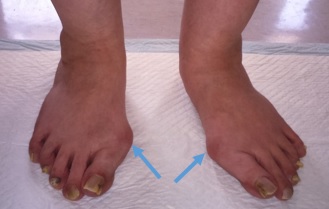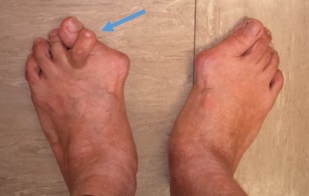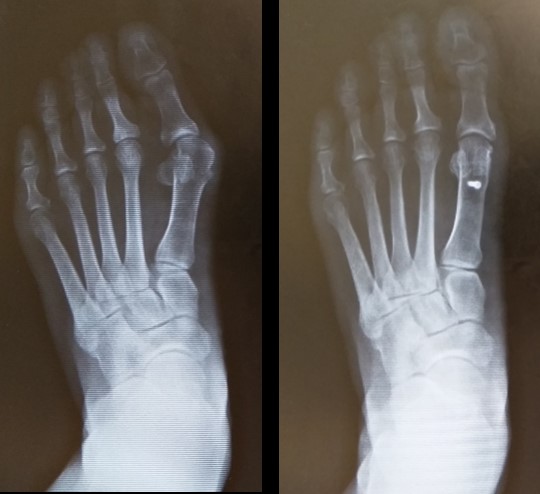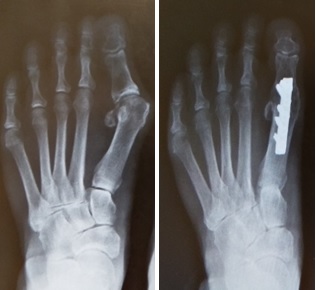Introduction
Hallux valgus is a progressive forefoot deformity with deviation of big toe towards the lesser toes. It is more common in women and 70% of the affected have positive family history.
Investigation
X-ray of the foot is taken to assess the severity of hallux valgus. Usually it should include at least three weight-bearing views: dorso-plantar, oblique and lateral view.
Grading
Hallux valgus can be graded according to its severity. An angle is measured between the big toe and the first long bone in the foot. This angle is called hallux valgus angle (HVA). [Figure 1] Mild deformity refers to an HVA of less than 20 degree. Moderate deformity refers to an HVA between 20 to 40 degrees. Severe deformity refers to an HVA more than 40 degrees.

Risk Factors
There are intrinsic and extrinsic risk factors. Intrinsic risk factors include genetic predisposition, general ligament laxity, pes planus deformity, rheumatoid arthritis and cerebral palsy. Extrinsic factors include improper footwear with tight and narrow shoebox.
Symptoms
Patients may complain of difficulty in wearing certain kinds of shoes and pain over the bunion (bony lump over the base of big toe). [Figure 2] Pain over the plantar side of the second metatarsal head is also common and is called metatarsalgia.

Signs
There could be associated claw toe deformities and over-riding second toe. [Figure 3] Callosity is common and could be found on the plantar side of metatarsal head and toe dorsum. The range of movement of the first metatarso-phalangeal joint could be reduced. There could also be associated flat foot deformity and tight Achilles tendon.

Treatment
Conservative treatment. Proper footwear is recommended with large toe box. Tight toe box could make the deformity worse. Insoles could be used for patients with flat foot deformity. Orthosis including toe spacer and night splint are used to prevent further deterioration of the deformity. Metatarsal pad is used to relieve pain over the bunion. [Figure 4] However, all these measures could not revert a deformed big toe back to its normal position.

Surgical treatment. It is recommended for patients who fail conservative treatment and complain of intolerable bunion pain which may affect activities of daily living and the quality of life. There have been over one hundred different kinds of surgical procedures described in the literature for the treatment of hallux valgus. It could be reconstructive procedures involving cutting of bone to realign the big toe, e.g. Chevron’s osteotomy. [Figure 5-6] It could be fusion procedures combining the joint between the big toe and the first long bone of the foot. [Figure 7]



References
- Easley ME, Trnka H-J. Current Concepts Review: Hallux Valgus Part 1: Pathomechanics, Clinical Assessment, and Nonoperative Management. Foot Ankle Int. 2007; 28(5):654-659.
- Coughlin MJ, Jones CP. Hallux valgus: demographics, etiology, and radiographic assessment. Foot Ankle Int. 2007 Jul; 28(7):759-77.
- Fraissler L, Konrads C, Hoberg M et al. Treatment of hallux valgus deformity. EFORT Open Rev. 2016 Aug; 1(8):295-302.
- Shi, Glenn G. MD; Whalen, Joseph L. MD, PhD; Turner, Norman S. III MD et al. Operative Approach to Adult Hallux Valgus Deformity: Principles and Techniques, J Am Acad Orthop Surg. 2020 May; 28(10): 410-418.
- Klugarova J, Hood V, Bath-Hextall F et al. Effectiveness of surgery for adults with hallux valgus deformity: a systematic review. JBI Database System Rev Implement Rep. 2017 Jun; 15(6):1671-1710.
Written by Dr. Diane Tai Hei-yan
13 January 2021
